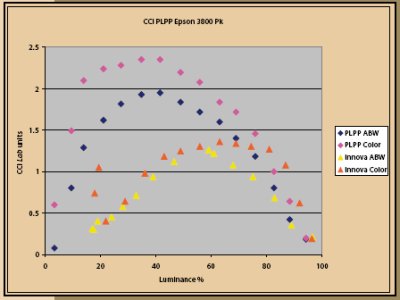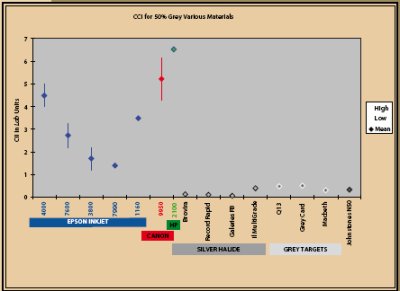articles/Paper/endofterm-page5
Great Paper End of Term Report - part 5 of 1 2 3 4 5 6 7 8 9
by Mike McNamee Published 01/02/2010

Before settling upon the use of CII we went back into our archive of audit prints (yes we keep them!) and measured the CII values (about 100 measurements in all). What we found for the nominally 50% grey patches is shown in the graph. We also looked at the variation either side of 50% grey across the luminance range. The 'hump' tracks our previous findings of metameric index, as do the improvements brought about by using reduced amounts of coloured inks for the Epson ABW driver. This confirms what we know from experience, the mono prints made with ABW are better! The data also confirms the almost perfect colour constancy of silver-halide mono prints.

There is a body of research work available on the studies that have been carried out, specifically those that attempt to optimise colour constancy. This technology has been fed back into the Epson Ultrachrome ink sets as they have improved over the past few years. In general we found our data to be gratifyingly close to the reported ones. The entire process is a balancing act between good colour rendition in terms of accuracy, colour gamut and colour inconstancy. The scientists at least have plenty to work with in terms of pushing and pulling the lookup tables about; the number of inks exceeds the number of colour variables to be optimised which makes things mathematically complex but offers a number of ways of achieving any given colour value.
The Metameric Index is usually expressed in Lab units, somewhat at odds with our own desire to use ΔE₀₀. Colour Inconstancy Index is expressed in a variety of error dimensions including both Lab and ΔE₀₀.
Please Note:
There is more than one page for this Article.
You are currently on page 5
- Great Paper End of Term Report page 1
- Great Paper End of Term Report page 2
- Great Paper End of Term Report page 3
- Great Paper End of Term Report page 4
- Great Paper End of Term Report page 5
- Great Paper End of Term Report page 6
- Great Paper End of Term Report page 7
- Great Paper End of Term Report page 8
- Great Paper End of Term Report page 9
1st Published 01/02/2010
last update 09/12/2022 14:53:49
More Paper Articles
There are 0 days to get ready for The Society of Photographers Convention and Trade Show at The Novotel London West, Hammersmith ...
which starts on Wednesday 15th January 2025





